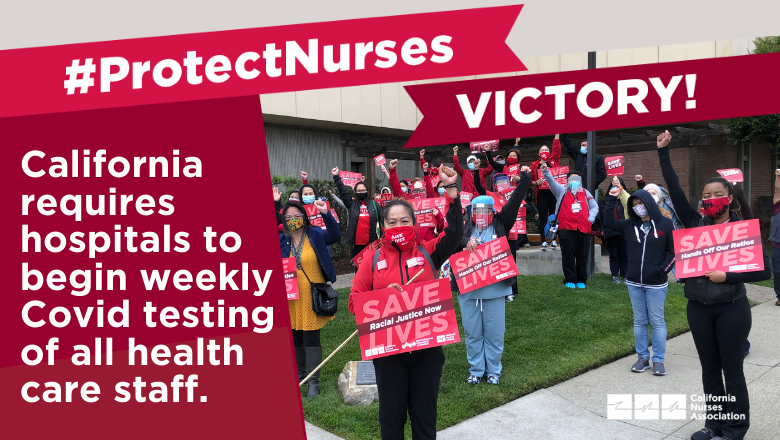Press Release
California nurses score huge win: State directs hospitals to begin weekly Covid testing of all health care staff Dec. 14 and testing of all patients now

Nurses scored a tremendous victory for the type of infection control measures they have been demanding since the start of the pandemic when the California Department of Public Health (CDPH) on Wednesday directed all general acute-care hospitals in the state to begin Covid-19 weekly testing of all health care workers on Dec. 14 and of all patient admissions starting now, announced the California Nurses Association (CNA).
Importantly, CDPH is directing that health care personnel with symptoms of Covid-19 be tested immediately.
“This is an amazing and welcome move,” said Zenei Triunfo-Cortez, a Bay Area RN and a president of CNA as well as National Nurses United (NNU), the larger national nursing organization with which CNA is affiliated. “We applaud California for being a leader in requiring this type of testing program because it is desperately needed to fight this virus. There are simply too many asymptomatic people with Covid, and without robust testing, our hospitals will remain centers for spreading the disease instead of centers of healing as they should be.”
The California Department of Public Health (CDPH) informed hospitals through an all-facilities letter on Nov. 25 of this new requirement. Hospitals may also start testing of “high-risk personnel” earlier, on Dec. 7, but testing of all health care personnel begins Dec. 14.
Health care personnel are defined as “all paid and unpaid persons serving in healthcare settings who have the potential for direct or indirect exposure to patients or infectious materials, including body substances (e.g., blood, tissue, and specific body fluids); contaminated medical supplies, devices, and equipment; contaminated environmental surfaces; or contaminated air. HCP include, but are not limited to, emergency medical service personnel, nurses, nursing assistants, physicians, technicians, therapists, phlebotomists, pharmacists, students and trainees, contractual staff not employed by the healthcare facility, and persons not directly involved in patient care, but who could be exposed to infectious agents that can be transmitted in the healthcare setting (e.g., clerical, dietary, environmental services, laundry, security, engineering and facilities management, administrative, billing, and volunteer personnel).”
In addition to the testing of staff and patients, hospitals must have a program that includes policies and procedures addressing the use of test results, including:
- How results will be explained to staff
- How to communicate information about any positive cases of staff in the facility to responsible parties
- How results will be tracked for staff at the facility and methods for reporting results to CDPH and the local health department
- How results will be used to guide implementation of infection control measures, including plans for notification and testing of other staff and patients exposed to positive staff
- A procedure for addressing staff that decline or are unable to be tested
- Plans to address potential staffing shortages for positive staff who are excluded from work
“This testing requirement has been a long time coming,” said Cathy Kennedy, a Sacramento-area RN and a president of CNA and executive vice president of NNU. “We nurses knew this was needed and fought together to make it happen. Now hospitals in the rest of the country just need to do the same to get this virus under control.”